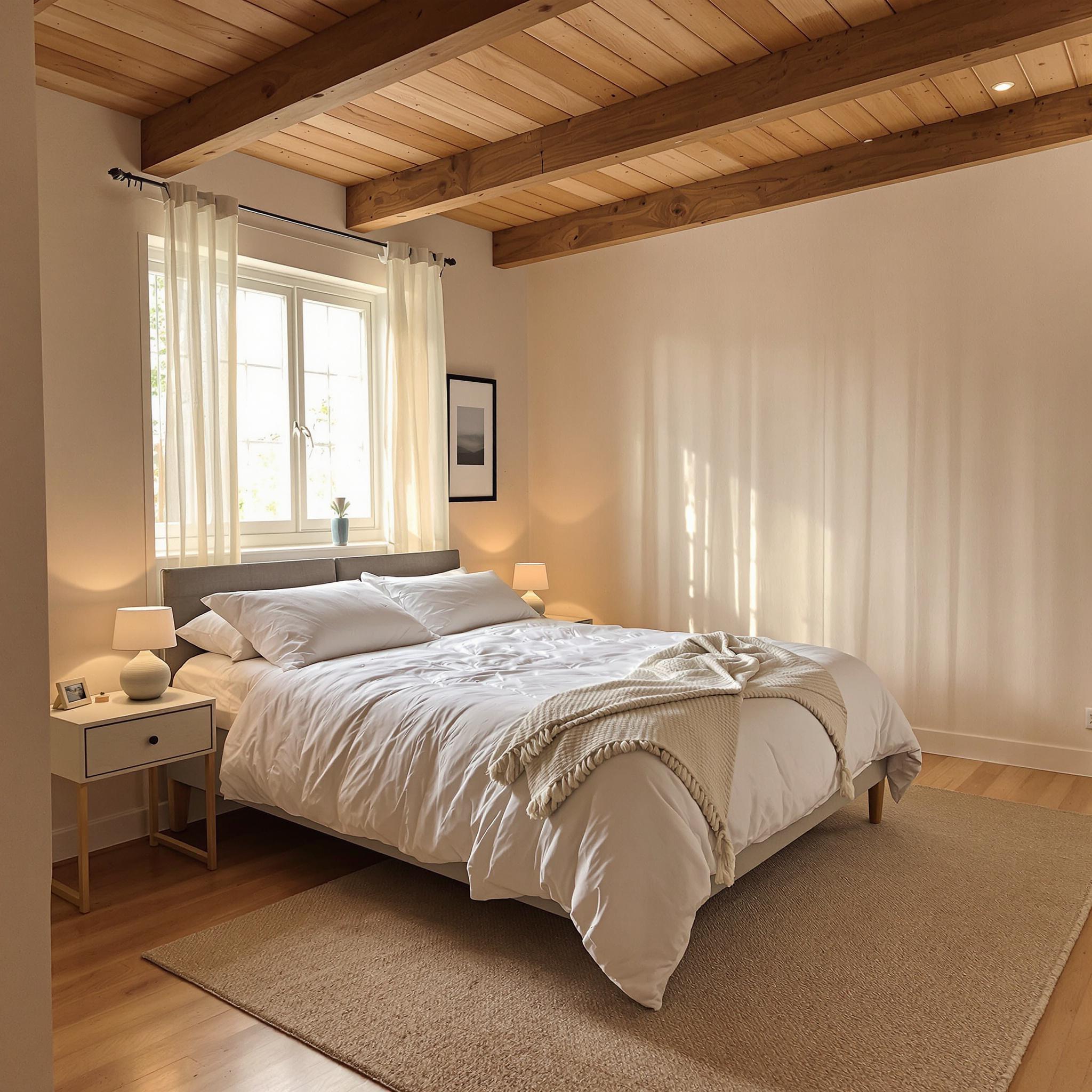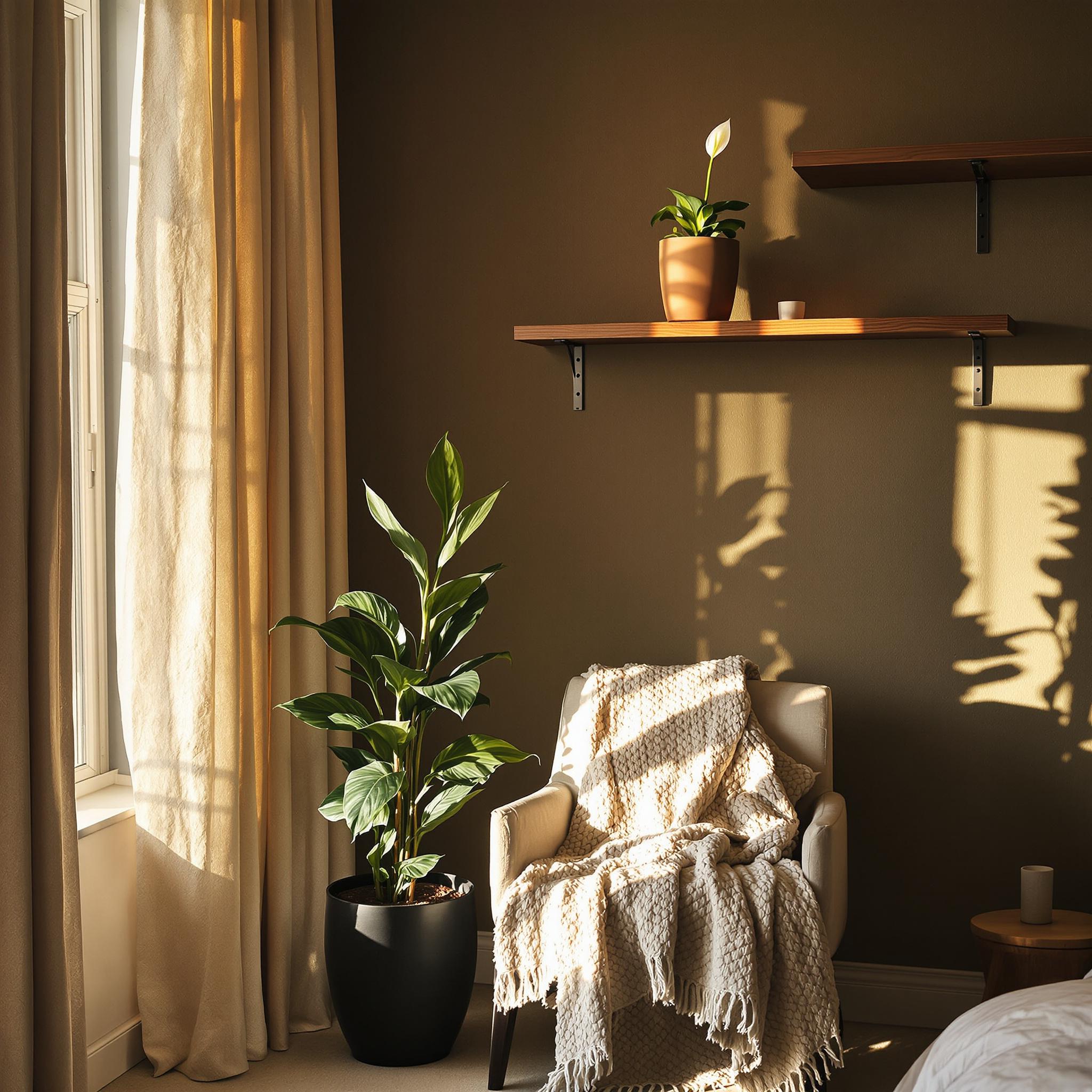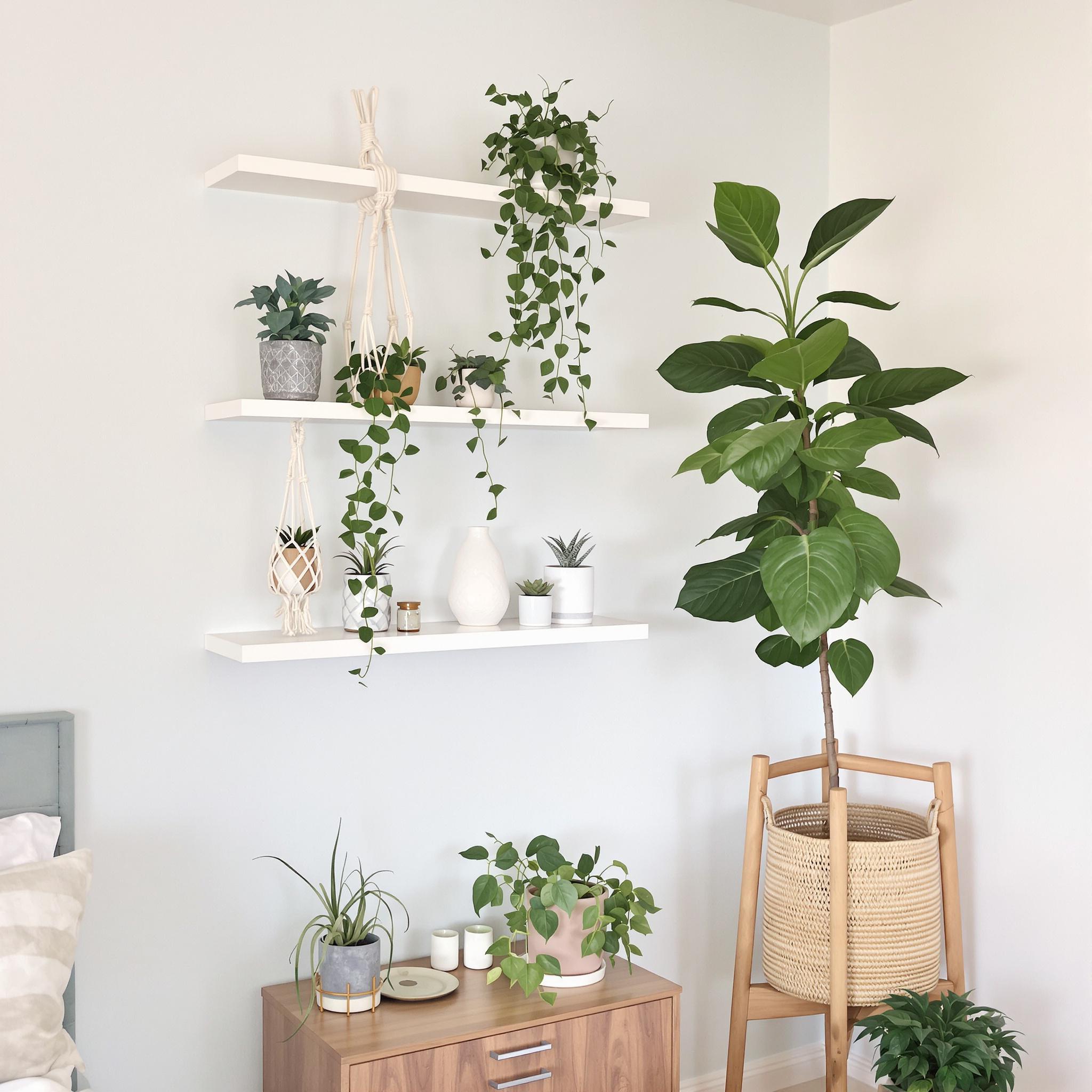Why a Calming Bedroom Matters for Sleep and Relaxation
A calming bedroom is more than just a nice idea. It’s essential for good sleep and relaxation. Stress can make it hard to unwind at night. A peaceful space helps your mind slow down. This leads to better rest and improved well-being.
Think about how you feel in a cluttered room. It’s hard to relax, right? Now imagine a clean, soothing space. You breathe easier. Your thoughts settle. Bedrooms should be a retreat from daily stress. They’re where you recharge for the next day.
I once turned my own bedroom into a calming oasis. I swapped harsh lights for soft ones. I added cozy fabrics and muted colors. The change was amazing. My sleep improved almost overnight. If you value rest, creating calm in your bedroom is key.
How Plants Bring Tranquility to Your Bedroom
Plants are a simple way to boost bedroom calmness. They improve air quality by removing toxins. Cleaner air helps you breathe better while you sleep. Some plants even release oxygen at night, which can aid relaxation.
Plants also reduce stress. Studies show that being around greenery lowers cortisol levels. Cortisol is the hormone tied to stress. Lower levels mean a calmer mind. Simply looking at plants can make you feel more at ease.
Their natural beauty adds charm too. A leafy plant or a blooming flower brings life to a room. It creates a connection to nature. This link has a grounding effect on the mind. I added a snake plant to my room last year. Its presence made the space feel warmer and more inviting.
Choosing the Right Plants for Your Bedroom
Not all plants are ideal for bedrooms. Consider light levels first. Most bedrooms have low to moderate light. Pick plants that thrive in these conditions. Examples include pothos, peace lilies, and ZZ plants.
Maintenance needs matter too. You don’t want a high-maintenance plant in your bedroom. Choose ones that require little water or attention. Succulents and snake plants are great options. They survive neglect and still look good.
Safety is another factor. Ensure plants are non-toxic, especially if you have pets or kids. Some plants, like philodendrons, can be harmful if ingested. Stick to safe choices like spider plants or Boston ferns. These are both pet-friendly and easy to care for.
Understanding Biophilia and Mental Well-Being
Biophilia is the idea that humans crave a connection to nature. This bond is vital for mental health. Nature reduces anxiety and lifts moods. Adding plants to your bedroom taps into this natural instinct.
When you surround yourself with greenery, you feel more balanced. Plants remind us of forests, gardens, and open spaces. These environments are linked to calmness and happiness. Even small touches of nature make a big difference indoors.
I noticed this during a tough time in my life. I filled my home with plants. The act of caring for them brought me joy. Watching them grow gave me a sense of purpose. Bedrooms with natural elements feel less sterile and more alive.
Tips for Incorporating Plants into Your Bedroom
Start small when adding plants to your bedroom. One or two plants can transform the space. Place them near windows for natural light. Or use low-light plants if your room is dim.
Group plants together for a lush look. Mix different sizes and shapes. Tall plants like fiddle-leaf figs add height. Smaller ones like succulents fill empty spots. This layering creates visual interest.
Don’t forget about planters. Choose pots that match your decor. Neutral tones blend well with most styles. Bold colors or patterns can add personality. Make sure pots have drainage holes to keep plants healthy.
Common Mistakes to Avoid When Using Plants in Bedrooms
Avoid overwatering your plants. Many people kill plants with kindness. Check soil moisture before watering. Most plants prefer to dry out between waterings.
Don’t overcrowd your bedroom with plants. Too many can make the space feel chaotic. Stick to a few well-placed options. Balance greenery with open areas for a calm vibe.
Skip plants with strong scents in the bedroom. Lavender or jasmine might smell nice. But strong odors can irritate some people. Opt for unscented plants like snake plants or ZZ plants instead.
Final Thoughts on Creating a Plant-Friendly Bedroom
A calming bedroom supports better sleep and relaxation. Plants play a big role in achieving this. They clean the air, reduce stress, and bring beauty to your space. Choose wisely based on light, maintenance, and safety.
Remember the concept of biophilia. Connecting with nature improves mental health. Plants are an easy way to bring this connection indoors. Start small and build from there. Your bedroom will feel like a sanctuary in no time.
Low-Maintenance Heroes: Snake Plants and Peace Lilies
Let’s start with two rock stars of the plant world—snake plants and peace lilies. If you’re the kind of person who forgets to water plants, these are your go-to options. Snake plants, or *Sansevieria*, don’t need much attention. They thrive in low light and can handle weeks without water. Pop one in a corner or on a side table for a subtle touch.
Here’s the cool part: snake plants clean the air while you sleep. They absorb toxins like formaldehyde and release oxygen at night. A buddy of mine swore her snake plant helped clear funky smells in a new apartment. Coincidence? Maybe. But it worked for her.
Peace lilies (*Spathiphyllum*) are another solid choice. Their shiny leaves and white blooms add calm vibes to any room. They also filter out bad stuff like ammonia and benzene. Just give them indirect light and water when the soil feels dry. Keep them away from heat sources, though—they like cooler spots. A shelf by the window works great.
Pairing a snake plant with a peace lily gives a nice mix. One is structured, the other soft. Think of them as the Batman and Robin of plants, but leafier.
Aromatic Allies: Lavender and Jasmine
Now let’s talk about smell. Who doesn’t love a room that smells amazing? Lavender and jasmine are the champs here. These plants not only look good but also help you relax with their soothing scents.
Lavender has been used forever to calm people down. Studies show its scent slows heart rates and cuts anxiety. I kept a small lavender plant on my nightstand during finals week in college. It felt like having a tiny stress-relief coach whispering, “Relax.” It’s easy to care for—just give it bright, indirect light and let the soil dry between waterings. Overwatering is its worst enemy.
Jasmine is lavender’s fancier cousin. Its sweet floral scent boosts mood and eases stress. Imagine falling asleep surrounded by its aroma—it’s like a spa in your room. Jasmine likes humidity, so mist its leaves occasionally. Keep it in filtered light, like near a window with a sheer curtain.
I love grouping lavender and jasmine together. They look great next to each other, and their scents blend beautifully. Add some soft lighting and a cozy blanket, and you’ve got a dreamy setup.
Tropical Touches: ZZ Plants and Aloe Vera
Want a tropical vibe? ZZ plants and aloe vera are perfect. Both are low-effort and packed with perks.
ZZ plants (*Zamioculcas zamiifolia*) are nearly indestructible. Low light? No big deal. Rare watering? They don’t mind. Stick one in a dim corner to fill space. Bonus: they clean the air by removing toxins like xylene and toluene.
Aloe vera is a multitasker. Its spiky leaves look cool, and it purifies the air too. Like snake plants, it releases oxygen at night. Plus, you’ve got fresh aloe gel handy for minor burns or skin issues. Win-win.
I once paired an aloe vera with a ZZ plant on a narrow table. The contrast between the smooth ZZ leaves and fleshy aloe spikes looked sharp. Tip: mix plants with different shapes and heights for visual interest. Just don’t overdo it—three or four plants per area is plenty.
Combining Plants for Maximum Impact
So how do you put it all together without making your bedroom look like a jungle? Balance is key. Mix tall plants like snake plants with trailing ones like pothos or ivy. This adds depth and keeps things interesting.
Layer your setup. Place bigger plants on the floor and smaller ones on shelves or furniture. This draws the eye up and makes the room feel more dynamic. Matching pots or complementary containers tie everything together. Neutral ceramic pots suit a minimalist style, while colorful ones add personality.
Funny story: I crammed five plants onto one bookshelf once. Big mistake. It looked messy, and the plants fought for light. Lesson learned—less is more. Aim for a clean, cohesive look. Trust me, your room will thank you.
Caring for Your Bedroom Oasis
Even low-maintenance plants need a little love. Set a weekly reminder to check on them. Dusty leaves? Wipe them with a damp cloth. Dry soil? Time to water. Small actions make a big difference.
Rotate your plants now and then so they get even light. This stops them from leaning toward the window. If leaves turn yellow, it might mean too much water or not enough light. Adjust as needed.
Bottom line: creating a calming bedroom with plants isn’t rocket science. Start small, play around with placement, and enjoy the process. Before long, you’ll have a peaceful spot that feels like fresh air.
Creative Ways to Display Plants in Your Bedroom
Let’s talk about making your bedroom feel like a jungle retreat. You don’t need to go overboard with plants right away. Think smart. Hanging pots are perfect if you’re low on space. I’ve got a pothos hanging by my window, and it feels magical when the light hits it. Macramé holders or modern hangers add style while keeping things light.
Shelves work great too. I used to think shelves were just for books. Then I started adding plants. Mixing tall snake plants with small succulents creates texture. Group plants in odd numbers—it’s oddly satisfying. Floating shelves keep things tidy and out of the way.
Plant stands are lifesavers. They let you show off big plants without taking up floor space. A fiddle-leaf fig on a stylish stand can transform any corner. Giving your plant a pedestal feels good.
Balancing Greenery With Your Bedroom Decor
Balancing plants with your decor can be tricky. Too many, and it feels like a greenhouse. Too few, and it’s just for show. The key is harmony. Plants should enhance your style, not clash with it. If your room is neutral, bold plants like monstera or calathea stand out. For colorful rooms, stick to simpler greens like peace lilies.
I once crammed five large plants into a tiny boho room. It looked chaotic. Lesson learned: size matters. Small spaces need compact plants like ZZ plants or air plants. Bigger rooms can handle rubber trees or bird-of-paradise.
Don’t forget about pots—they’re accessories for your plants. Terracotta feels rustic; ceramic looks sleek. I swapped a plastic pot for a matte black one, and my nightstand instantly looked better. Who knew?
Potential Challenges (And How to Overcome Them)
Plants are awesome but come with challenges. Allergies are a big one. Some people sneeze at pollen-heavy flowers. Stick to low-allergen plants like ferns or ivy. Air-purifying plants like snake plants are great too.
Pests? No one wants bugs in their bedroom. Watch for sticky residue or webs. Wipe leaves often and avoid overwatering—fungus gnats love soggy soil. I learned this the hard way with my peace lily.
Ventilation matters. Plants need fresh air, but bedrooms are often closed off. Crack a window or use a fan. Keep plants away from heat sources like radiators—they’ll dry out.
Starting Small and Expanding Gradually
If you’re new to indoor plants, take it slow. Start with easy-care plants like peace lilies, pothos, or snake plants. They’ll teach you basics like watering and light needs.
My first plant was a succulent. I killed it by overwatering. Turns out, succulents hate soggy roots. Learn from my mistake! Start with tough plants, then try finicky ones like orchids later.
Now, I set weekly reminders to check my plants. It’s like a date with nature. I added more plants gradually, making sure each fit my space. Don’t rush—let your garden grow naturally.
Final Thoughts
Adding plants to your bedroom isn’t just about looks. It’s about creating a relaxing space. Whether you hang plants, put them on shelves, or add one standout piece, do it thoughtfully. Start small, solve problems as they come, and enjoy the process. A bit of greenery can change your mood—and your room—for the better.
Frequently Asked Questions About Bedroom Plants
- What are the best low-light plants for bedrooms?
Snake plants, ZZ plants, and pothos do well in low light. Perfect for dim corners. - Can bedroom plants trigger allergies?
Most won’t cause issues. Avoid strong-smelling blooms like jasmine. Go for hypoallergenic options like ferns. - How often should I water my bedroom plants?
It depends. Succulents need little water; tropicals like peace lilies need more. Check the soil first. - Do plants improve sleep quality?
Some, like lavender, might help. Research is mixed. Choose plants that make you feel calm. - Are there pet-safe plants for bedrooms?
Yes! Spider plants, Boston ferns, and African violets are safe. Double-check plants before buying. - How do I prevent pests on my plants?
Don’t overwater. Inspect leaves often. Isolate new plants. Use neem oil if needed. - Should I mist my plants?
Tropical plants like ferns benefit from misting. Cacti don’t. Know your plant’s needs. - Where should I place plants in a small bedroom?
Use vertical space with hanging pots or shelves. Corners and windowsills work too. - How do I choose pots that match my decor?
Match pot colors to your furniture or accents. Neutral tones blend easily; metallics add shine. - Can I grow herbs in my bedroom?
Absolutely! Mint or basil grow well near sunny windows. Bonus: fresh herbs for cooking!



